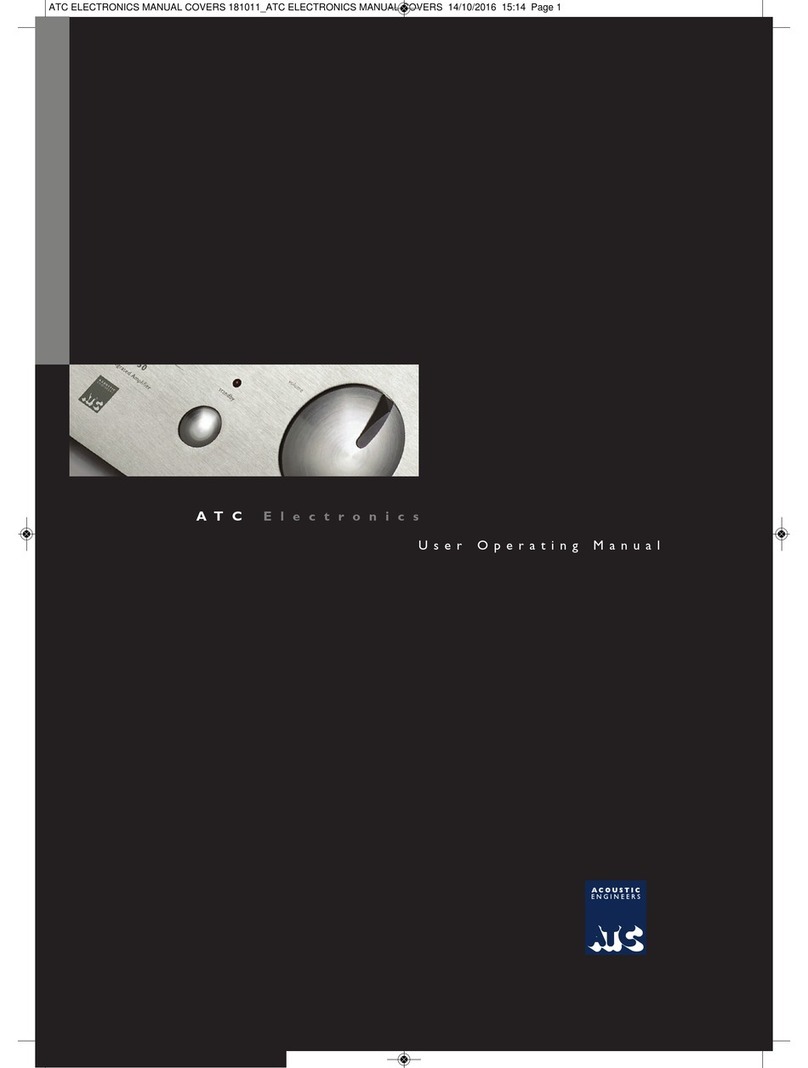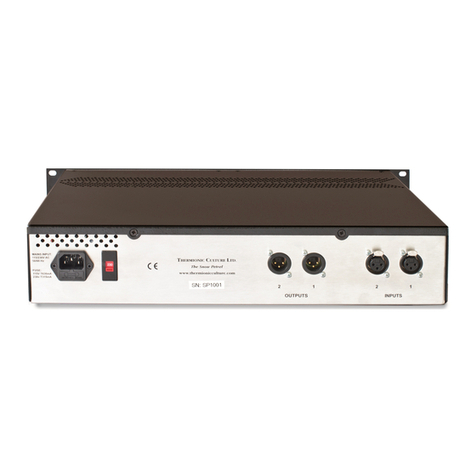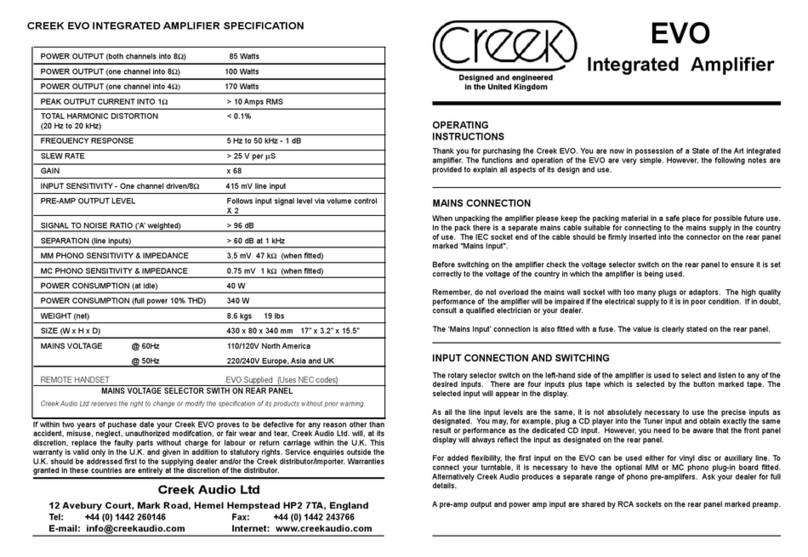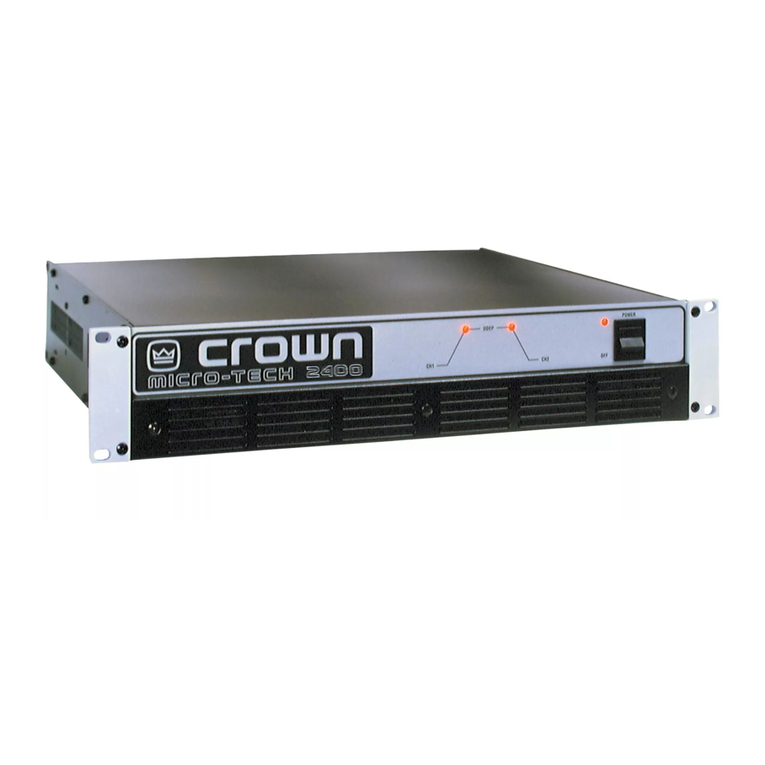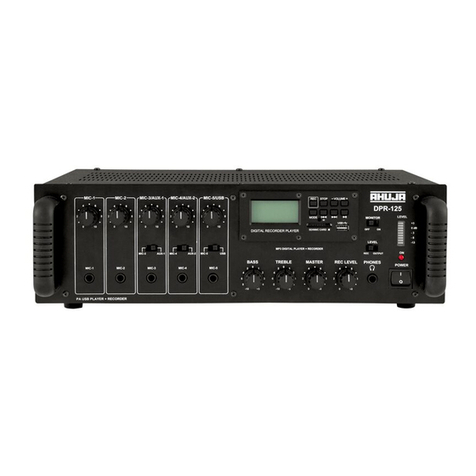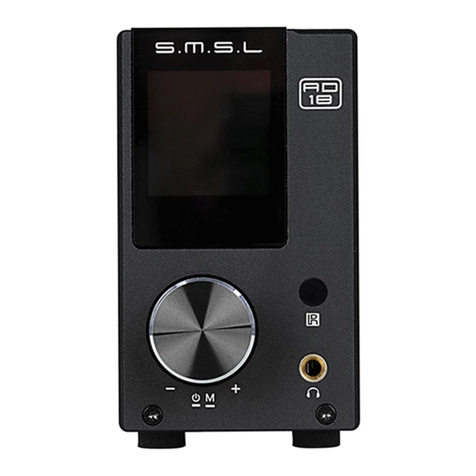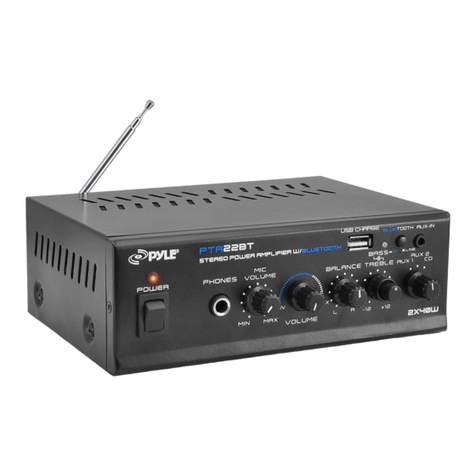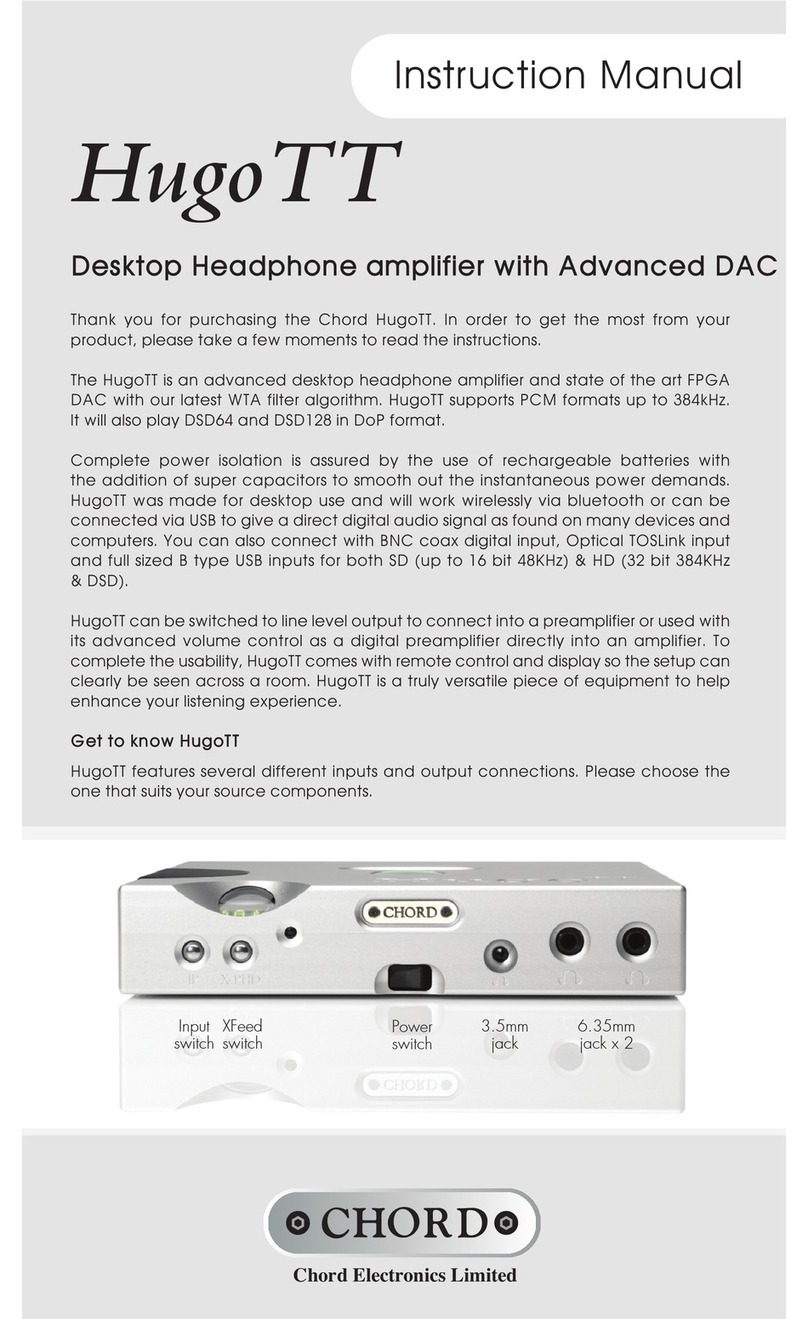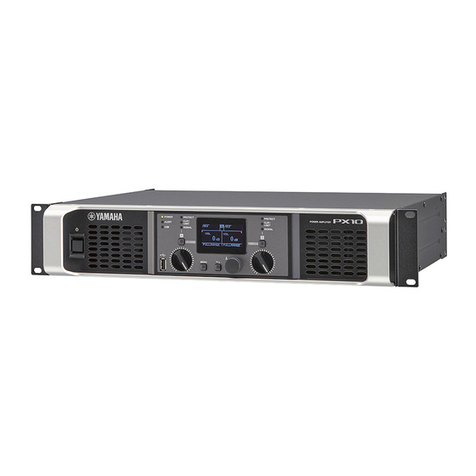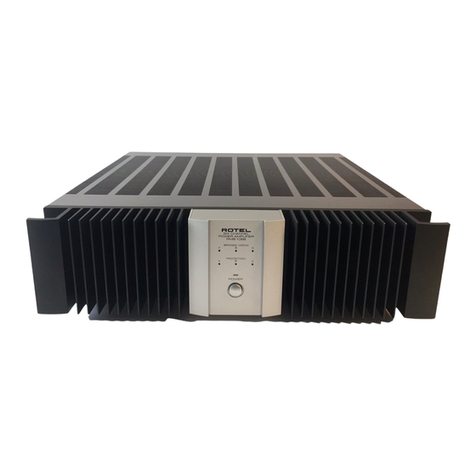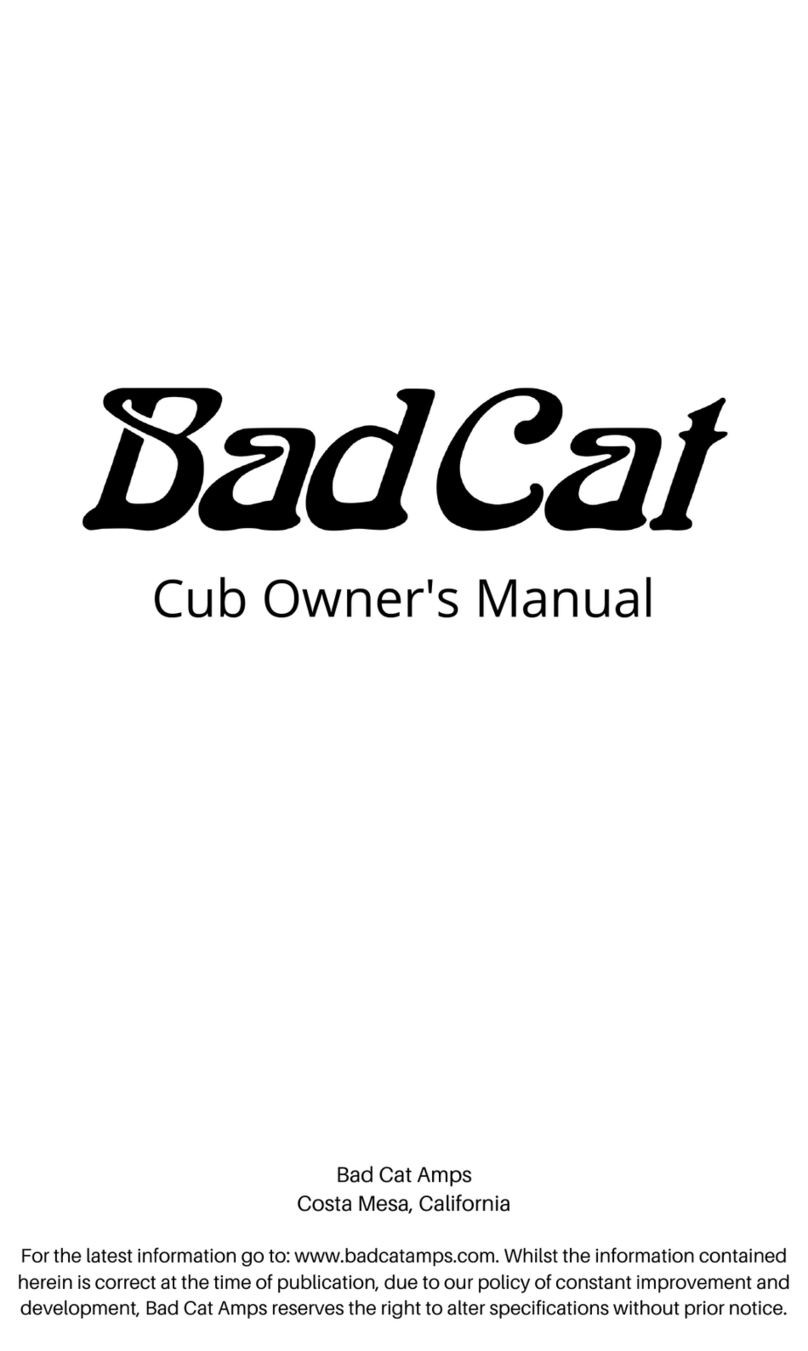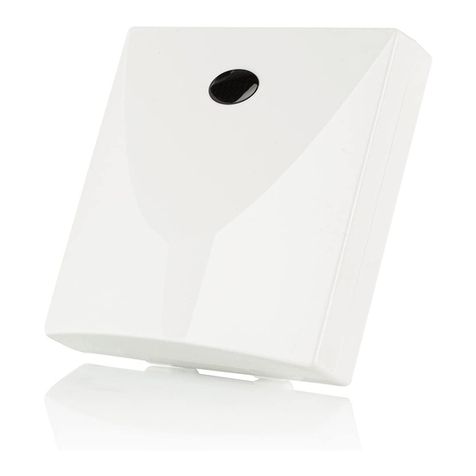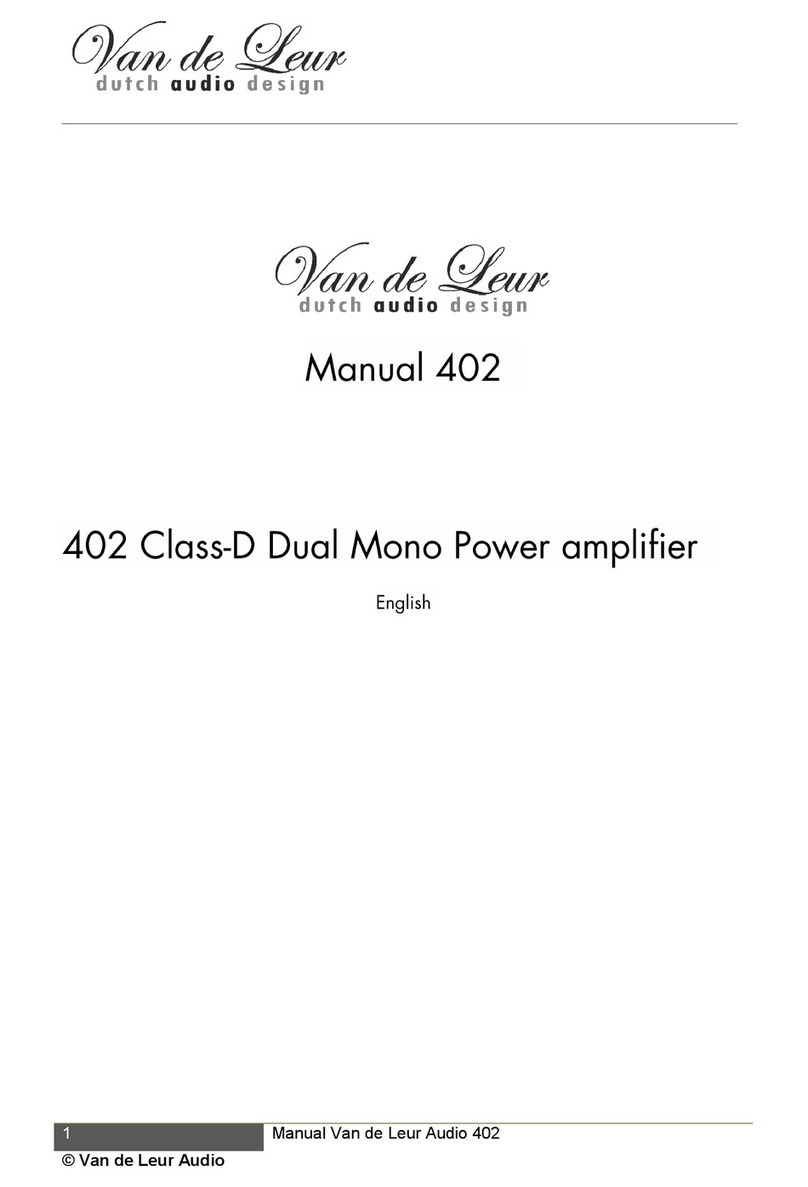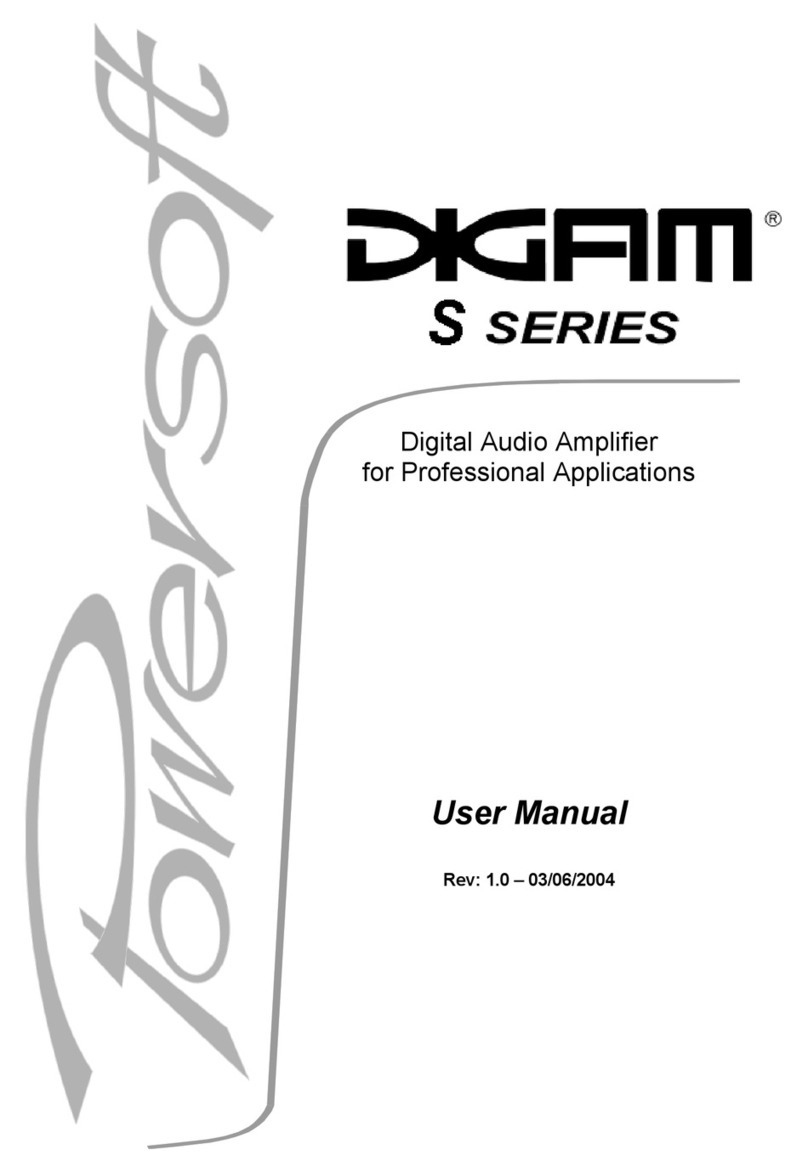BlueTube Audio BT-4 Owner's manual

BlueTube Audio
Vacuum Tube Amplier
BT-4
BT-6
Owner’s & Operator’s Manual

I - SAFETY PRECAUTIONS
SAFETY PRECAUTIONS
RISK OF ELECTRIC
SHOCK DO NOT OPEN
CAUTION
CAUTION:
TO REDUCE THE RISK OF ELECTRIC SHOCK, DO NOT REMOVE
COVER (OR BACK). NO USER-SERVICEABLE PARTS INSIDE.
REFER SERVICING TO A QUALIFIED SERVICE PERSONNEL.
The lightning ash with arrowhead symbol, within an
equilateral triangle, is intended to alert the user to the
presence of uninsulated “dangerous voltage” within the
product’s enclosure that may be of sufcient magnitude to
constitute a risk of electric shock to persons.
The exclamation point within an equilateral triangle is
intended to alert the user to the presence of important
operating and maintenance (servicing) instructions in the
literature accompanying the appliance.
Hot
Surface
Mark
CAUTION:
HOT SURFACE. DO NOT TOUCH.
The glass vacuum tubes on top of the appliance
will become very hot when operating the product
continuously.
Do not touch hot areas, especially around the “Hot
Surface Mark” and the glass vacuum tubes.

SAFETY PRECAUTIONS - II
IMPORTANT SAFETY
INSTRUCTIONS
1. Read these instructions.
2. Keep these instructions.
3. Heed all warnings.
4. Follow all instructions.
5. Do not use this apparatus near water.
6. Clean only with dry cloth.
7. Do not block any ventilation openings.
8. Install in accordance with the manufacturer’s instructions.
9. Do not install near any heat sources such as radiators, heat
registers, stoves, or other apparatus (including ampliers) that
produce heat.
10. Do not defeat the safety purpose of the polarized or grounding-type
plug. A polarized plug has two blades with one wider than the other.
A grounding type plug has two blades and a third grounding prong.
The wide blade or the third prong are provided for your safety. If the
provided plug does not t into your outlet, consult an electrician for
replacement of the obsolete outlet.
11. Protect the power cord from being walked on or pinched particularly
at plugs, convenience receptacles, and the point where they exit
from the apparatus.
12. Only use attachments/accessories specied by the manufacturer.
13. Unplug this apparatus during lightning storms.
14. Refer all servicing to qualied service personnel.
CAUTION:
To completely disconnect this product from the mains, disconnect the plug
from the wall socket outlet.
The mains plug is used to completely interrupt the power supply to the unit
and must be within easy access by the user.

III - NOTES ON USE
NOTES ON USE
WARNINGS
• Avoid high temperatures.
• Allow for sufcient heat dispersion when installed enclosed in a rack.
• Handle the power cord carefully.
• Hold the plug when unplugging the cord.
• Keep the unit free from moisture, water, and dust.
• Unplug the power cord when not using the unit for long periods of time.
• Do not obstruct the ventilation holes.
• Do not let foreign objects into the unit.
• Do not let ammable substances come into contact with the unit.
• Never disassemble or modify the unit in any way.
• Ventilation should not be impeded by covering the ventilation openings
with items, such as newspapers, tablecloths or curtains.
• Naked ame sources such as lighted candles should not be placed on the
unit.
• Do not expose the unit to dripping or splashing uids.
• Do not place objects lled with liquids, such as vases, on the unit.
• Do not handle the mains cord with wet hands.
• When the switch is in the OFF position, the equipment is not completely
switched off from MAINS.
• The equipment shall be installed near the power supply so that the power
supply is easily accessible.
VACUUM TUBES BECOME VERY HOT!
• Never touch vacuum tubes if unit is on or has been on within an hour.
• Keep children away from vacuum tubes.
• Keep animals away from vacuum tubes.
• Never spray cleaner or any liquid directly on tubes even if not hot.
• Keep vacuum tubes away from curtains, clothing, fabric, etc.
• NEVER clean amplier while unit is on or tubes are still warm.

INSTALLATION - IV
Wall
For proper heat dispersion, do not install this
unit in a conned space, such as a bookcase or
similar enclosure.
• A minimum of 24 in. (0.6m) is recommended
above the unit.
• Do not place any other equipment on this unit.
*
DANGER
• NEVER INSTALL SHELVING ABOVE UNIT
• UNIT SHOULD NEVER BE INSTALLED IN BOOK CASE OR CONFINED
SPACE
• AT MINIMUM 24” (600mm) OF EMPTY SPACE IS REQUIRED ABOVE
THE UNIT
FAILURE TO FOLLOW THESE GUIDELINES COULD RESULT IN FIRE
CAUSING BODILY HARM OR DEATH
INSTALLATION

SAFETY PRECAUTIONS I
NOTES ON USE III
INSTALLATION IV
Table of Contents 1
Getting Started 3
What’s In the Box 3
Difference Between BT-4 and BT-6 3
Features 4
First Setup 5
Installing Tubes 5
Cautions on Handling 6
Controls 7
Front Panel 7
Turning Unit On 8
Changing the Volume 8
Switching Inputs 8
Connections 9
Rear Panel 9
Connecting an Audio Device (RCA Cables) 10
Connecting an Audio Device (1/8” Headphone Jack) 11
Connecting a Phono Player Using an External Preamp 12
Connecting to Bluetooth® 13
Connecting to the USB Charging Port 14
Connecting the Speakers 15
For Optimum Speaker Performance 16
Sub-woofer Inputs and Controls (optional) 17
Connecting Sub-woofer to BlueTube Amplier 19
Table of Contents
1 - Table of Contents

Switching Voltage 19
Connecting Headphones 20
Audio 21
Vacuum Tube Break-in 21
Bluetooth® Noise 21
Volume Level 21
Care of BlueTube Products 22
Service 22
Cleaning 22
Additional information 23
Troubleshooting 23
Limited Warranty 25
Table of Contents - 2
© 2013 BlueTube Audio, Inc. All rights reserved. Reproduction in whole or in part without
written permission is prohibited. iPod, iPhone, iPod touch, iPod classic, iPod nano, and
iPad are trademarks of Apple Inc. Android and Google Play are trademarks of Google, Inc.
Bluetooth is a trademark of Bluetooth SIG, Inc. All other trademarks are trademarks of their
respective owners. Features and specications are subject to change without notice.

3 - What’s In the Box
Getting Started
What’s In the Box
Check that the following parts are supplied with the product.
① Getting Started/Owners Manual
② Power Cord
③ Speaker Cable
④ 1/8” to RCA Cable
⑤ RCA Cable
⑥ 4x 10GV8 Vacuum Tubes (BT-4)
4x 6005W and 2x 5670W Vacuum Tubes (BT-6)
Difference Between BT-4 and BT-6
BT-4 BT-6
Input impedance 100k ohms 100k ohms
Output impedance 8 ohms 8 ohms
Output power 8 watts per channel 8 watts per channel
Circuit Class A - Push Pull Class A - Push Pull
Frequency response 20 to 20,000 Hz 20 to 20,000 Hz
Total harmonic distortion @1 Watt <1% @1 Watt <1%
# of Tubes 4 6
Voltage 115V/60hz 115-230V/50-60Hz
Tubes 4x 10GV8 4x6005W
(Pentode),
2x5670W(Triode)
Min input for full output .5V .5V
The only difference between the BT-4 and the BT-6 is the number of
tubes and the voltage capabilities. The BT-4 takes advantage of a
combination style tube where the single tube contains the pentode and
triode. Whereas the BT-6 uses a 3rd tube per channel and the pentode
and triode are in different tubes. The sound quality of both ampliers is
outstanding.

Features - 4
Features
Solid 3/4” walnut and cherry hand-rubbed, waxed enclosures
The 3/4” thick walnut and cherry enclosures are hand rubbed with
linseed oil, then waxed and are reminiscent of audio equipment built
50 years ago by craftsman.
True stereo output (8 watts per channel)
Class A push-pull amp for outstanding sound reproduction.
Internal Bluetooth® receiver with voice command setup, 2
hard-wired inputs
Gold Plated Auxiliary RCA jacks allow you to connect up to two (2)
additional audio sources to the BlueTube Audio Amplier.
High quality Gold Plated “easy-connect” spring loaded speaker
connections
Gold Plated spring loaded binding posts allow for a quick and easy
connection to a set of BlueTube Audio speakers using the included
stranded speaker cable or using banana clips.
USB charging port to power and charge portable audio players
(iPhones®, Android®Phones, MP3 players, etc)
The charging port offers optimal power to today’s mobile devices.
Whether connecting to an iPhone®, iPad®, Android®, or any other
mobile device, the BlueTube Audio Ampliers Smart Circuitry
provides the appropriate power.
Sub-Woofer output
Audio Level Sub-woofer output.

5 - First Setup
First Setup
1. Unbox and verify contents.
2. Switch the voltage on the back to your appropriate voltage (BT-6
only) if unsure about your voltage consult a licensed electrician.
3. Plug in power cable.
4. Connect input devices.
5. Connect speakers. (Do not operate without speakers connected)
6. Connect sub-woofer (optional).
7. Install tubes (See below for instructions).
8. Turn unit on.
9. Enjoy!
Installing Tubes
Installing the tubes is a quick and simple procedure.
First, the old wives tale that you should never touch a vacuum tube is
false. While you should never touch a hot tube as you may suffer burns,
touching a cool tube with your bare hands is just ne.
1. Take note of the position of the pins on the bottom
of the vacuum tube. You will notice a section with no
pins. The pins that are there will correspond with the
pin holes on the socket on the amp.
2. Using your bare hands line up the pins with the
holes on the socket and apply a slow rocking even pressure until the
tube is seated.
3. Continue this process until all tubes are installed.
4. On the BT-6, the short fat tubes should be installed in the two front
holes.

Cautions on Handling - 6
Cautions on Handling
Before turning the power on
Check once again that all connections are correct and that there are no
problems with the connection cables.
Power is supplied to some of the circuitry even when the unit is set to the
OFF mode. When going on vacation or leaving home for long periods of
time, be sure to unplug the power cord from the power outlet.
About condensation
If there is a major difference in temperature between the inside of
the unit and the surroundings, condensation (dew) may form on the
operating parts inside the unit, causing the unit not to operate properly.
If this happens, let the unit sit for 4-6 hours with the power turned off and
wait until the temperature of the amp matches the ambient temperature
before using the unit.
Cautions on using mobile phones
Using a mobile phone near this unit may result in noise. If that occurs,
move the mobile phone away from this unit when it is in use.
Moving the unit
Turn off the power and unplug the power cord from the power outlet.
Next, disconnect the connection cables to other system units before
moving the unit. CAUTION: Tubes remain hot for 20 minutes or more.
About care
• Wipe the cabinet and control panel clean with a soft cloth.
• Do not spray cleaners on the glass tubes. Follow the care
instructions in this manual.
• Benzene, paint thinner or other organic solvents as well as
insecticide may cause material changes and discoloration if brought
into contact with the unit, and should therefore not be used.

7 - Front Panel
Controls
Front Panel
DO NOT rotate knobs past the built in stops, DAMAGE will occur.
Turn Volume Knob to half position when turning on.
1. Power Switch - ON/OFF Positions. Blue LED ring indicates power
is on.
2. Volume Knob - Controls volume level, turn clockwise to turn the
volume up, reverse direction to reduce the volume.
3. Input Selector Knob - Selects which input you want the amp to
output. Aux 1 and 2 are on the back of the amp. The third symbol is
for Bluetooth®. (see page 13 for Bluetooth® operations)
4. Auto-switching Headphone Output Jack - 1/4” headphone jack.
When headphones are plugged in, amp automatically turns speaker
outputs off and redirects output to headphones.

Turning Unit On - 8
Turning Unit On
Press power button until you hear a click,
release. Power button will now be ush
and is in the ON position. To turn unit off
press power button until you hear a click and
release. The power button will be slightly
protruding in the OFF position.
Changing the Volume
Turn the large volume knob in the center
clockwise to turn the volume up. Turn the
knob counter clockwise to turn the volume
down. NOTE: You should always have the
volume knob in the halfway position when
turning the unit on.
Switching Inputs
The input selector knob has 3 stops. Turn it
to have the arrow pointing at the input you
want to use. When pointing at the Bluetooth®
logo the unit will search for connected
devices, if none are found, it will go into the
Bluetooth® programming mode (For Bluetooth®
programming see page 13).

9 - Rear Panel
Connections
Note:
• Do not plug in the power cord until all connections have been
completed.
• When making connections, also refer to the operating instructions of
the other devices being connected.
• Be sure to connect the left and right channels properly (left with left,
right with right).
• Do not bundle power cords together with other cables. Doing so can
result in noise.
Rear Panel
1. Sub-woofer Output
2. Aux 1 input
3. Aux 2 input
4. USB Charger
5. Right Speaker Output
6. Left Speaker Output
7. 115V/230V voltage selector
(BT-6 only)
8. IEC Power connector/fuse
9. Cooling vents - DO NOT
BLOCK

Connecting an Audio Device (RCA Cables) - 10
Connecting an Audio Device (RCA Cables)
Using one of the supplied RCA cables, connect the red connector to
the right output of your device and the white connector to the left output
on the your device. On the other end of the cable, connect the red
connector to the right input of Aux 1 or Aux 2 on the BlueTube Audio
Amplier and connect the white connector to the left input of Aux 1 or
Aux 2 of the BlueTube Audio Amplier.

11 - Connecting an Audio Device (1/8” Phone Jack)
Connecting an Audio Device (1/8” Phone Jack)
Using a cable with RCA plugs on one end and an 1/8” headphone plug
on the other, connect the headphone plug to your device. On the other
end of the cable, connect the red connector to the right input of Aux 1 or
Aux 2 on the BlueTube Audio Amplier and connect the white connector
to the left input of Aux 1 or Aux 2 of the BlueTube Audio Amplier.

Connecting a Phono Player Using an External Preamp - 12
Connecting a Phono Player Using an External Preamp
NOTE: if your phono player does not have a built in preamp,
you will need to use an external pre-amp. (Not included)
If your turntable has a built in pre-amp and you don’t need to use an
external pre-amp, this page does not apply. Instead follow the directions
on connecting an Audio Input Device.
Using one of the supplied RCA cables, connect the red connector to the
right output of your pre-amp and the white connector to the left output
on the your preamp. On the other end of the cable, connect the red
connector to the right input of Aux 1 or Aux 2 on the BlueTube Audio
Amplier and connect the white connector to the left input of Aux 1 or
Aux 2 of the BlueTube Audio Amplier. Then
consult the users manual for the pre-amp
and phono player for instructions.

13 - Connecting to Bluetooth®
Connecting to Bluetooth®
Syncing Bluetooth®
1. Turn on amp and allow to warm up before selecting Bluetooth®
input.
2. Enable Bluetooth® on your device. This is usually located in the
“Settings” or “Options” area of your phone.
You may also need to nd the setting that
allows Bluetooth® devices to nd your
phone. Enable this setting.
3. Turn the input selector switch to Bluetooth®.
4. Follow the voice commands.
5. The BlueTube Audio Amplier will show up
as “BT-1A” on your devices menu.
6. You are now ready to listen to audio from
your device via Bluetooth®.
Notes on Using Bluetooth®.
• The BlueTube amp and your device should remember each other.
As long as your device’s Bluetooth® is still on, it should auto connect
to the BlueTube Audio Amplier.
• After a period of no connection, the Bluetooth® module will power
down. Move the selector knob from Bluetooth® to Aux 2 then back
to Bluetooth® to reconnect.
• Bluetooth® on any amp especially a vacuum tube amp is a
convenience. It does not and never will deliver the best audio
quality. For convenience you can use the Bluetooth® module,
however, for the best quality use the Aux 1 and Aux 2 inputs.
Bluetooth® must compress your audio, send it over the airwaves,
then uncompress it again. This will result in deterioration of audio
quality.
• Bluetooth® audio uses RF to transmit the audio. Being encased in
a vacuum tube amplier could result in some noise being picked up
from the high voltage transformers. This will usually only be noticed
at very low volumes.

Connecting to the USB Charging Port - 14
Connecting to the USB Charging Port
The USB port on the back of the amplier is for charging devices only
and has no ability to transmit data.
To use, simply connect your USB cable to the USB port. The smart
charging circuitry will take care of feeding the proper current to your
device.
• Unit will charge devices up to 1 Amp of current.
• Output will be automatically shut down to protect itself if more than
1 Amp of load is applied.
• When charging a device that is connected to the Amplier through
the device’s 1/8” headphone jack some noise could occur at low
volumes.
• On most USB cables, you will want to install it with the USB logo
facing up.

15 - Connecting the Speakers
Connecting the Speakers
1. Strip back about 1/2” of the insulation on each of the speaker wires
on both ends.
2. Connect the wire with the white stripe to the red binding post on right
speaker output.
3. Connect the wire with no stripe to the black binding post on the right
speaker output on the back of the amplier.
4. On the other end of the cable, connect the wire with the white stripe
to the red binding post on the back of the right speaker.
5. Connect the speaker wire with no stripe to the black binding post on
the back of the right speaker.
6. Repeat on the left side.
NOTE: If speaker connections are reversed (black to red and red
to black) the speakers will still produce sound, however, they
will be out of phase and the sound quality will not be optimal.
This manual suits for next models
1
Table of contents
